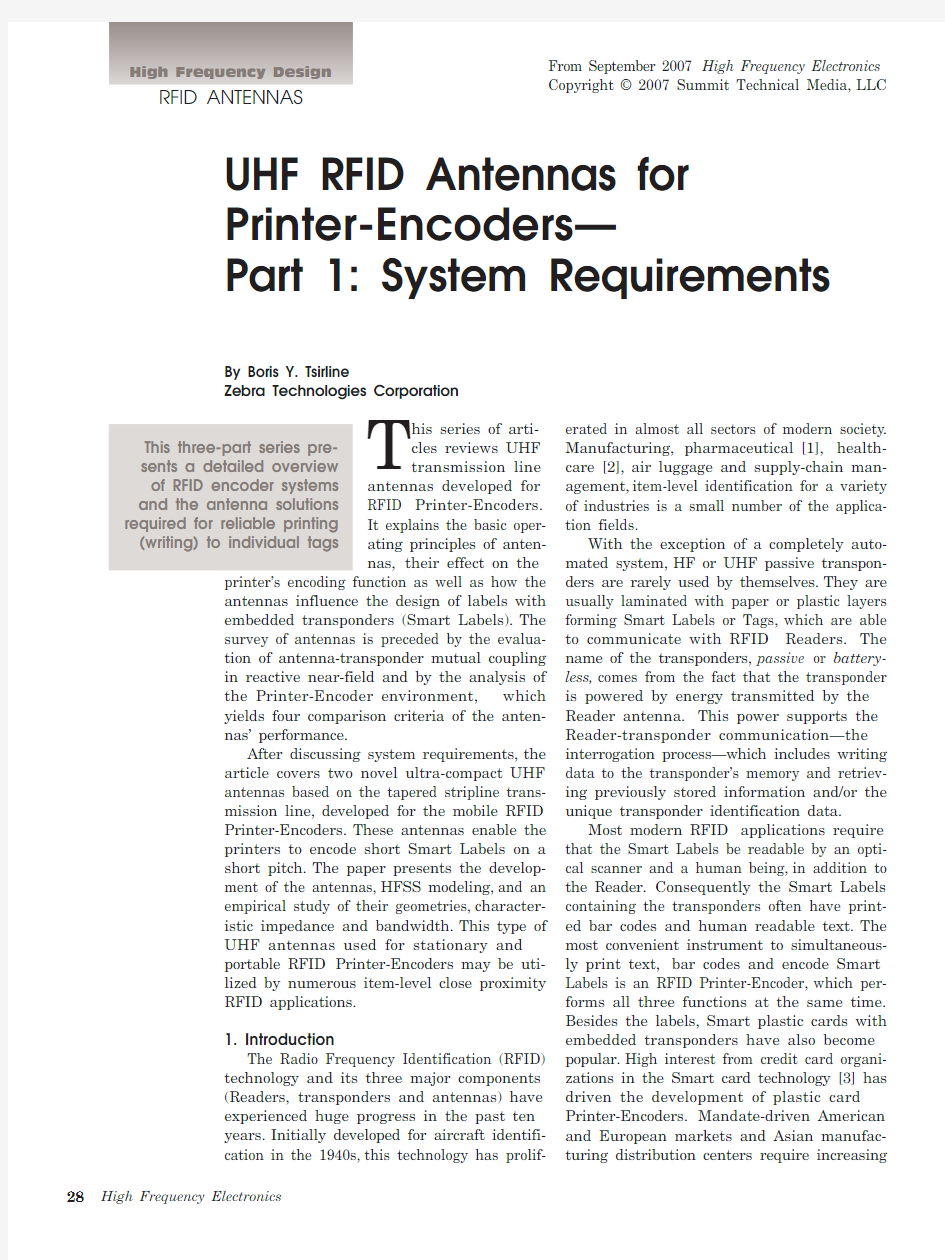RFID天线设计1


High Frequency Design
RFID ANTENNAS
UHF RFID Antennas for
Printer-Encoders—
Part 1: System Requirements
By Boris Y. Tsirline
Zebra Technologies Corporation
T his series of arti-
cles reviews UHF
transmission line
antennas developed for
RFID Printer-Encoders.
It explains the basic oper-
ating principles of anten-
nas,their effect on the printer’s encoding function as well as how the antennas influence the design of labels with embedded transponders (Smart Labels).The survey of antennas is preceded by the evalua-tion of antenna-transponder mutual coupling in reactive near-field and by the analysis of the Printer-Encoder environment,which yields four comparison criteria of the anten-nas’ performance.
After discussing system requirements,the article covers two novel ultra-compact UHF antennas based on the tapered stripline trans-mission line,developed for the mobile RFID Printer-Encoders.These antennas enable the printers to encode short Smart Labels on a short pitch.The paper presents the develop-ment of the antennas,HFSS modeling,and an empirical study of their geometries,character-istic impedance and bandwidth.This type of UHF antennas used for stationary and portable RFID Printer-Encoders may be uti-lized by numerous item-level close proximity RFID applications.
1. Introduction
The Radio Frequency Identification (RFID) technology and its three major components (Readers,transponders and antennas) have experienced huge progress in the past ten years.Initially developed for aircraft identifi-cation in the 1940s,this technology has prolif-erated in almost all sectors of modern society. Manufacturing,pharmaceutical [1],health-care [2],air luggage and supply-chain man-agement,item-level identification for a variety of industries is a small number of the applica-tion fields.
With the exception of a completely auto-mated system,HF or UHF passive transpon-ders are rarely used by themselves.They are usually laminated with paper or plastic layers forming Smart Labels or Tags,which are able to communicate with RFID Readers.The name of the transponders,passive or battery-less,comes from the fact that the transponder is powered by energy transmitted by the Reader antenna.This power supports the Reader-transponder communication—the interrogation process—which includes writing data to the transponder’s memory and retriev-ing previously stored information and/or the unique transponder identification data.
Most modern RFID applications require that the Smart Labels be readable by an opti-cal scanner and a human being,in addition to the Reader.Consequently the Smart Labels containing the transponders often have print-ed bar codes and human readable text.The most convenient instrument to simultaneous-ly print text,bar codes and encode Smart Labels is an RFID Printer-Encoder,which per-forms all three functions at the same time. Besides the labels,Smart plastic cards with embedded transponders have also become popular.High interest from credit card organi-zations in the Smart card technology [3] has driven the development of plastic card Printer-Encoders.Mandate-driven American and European markets and Asian manufac-turing distribution centers require increasing
This three-part series pre-sents a detailed overview
of RFID encoder systems and the antenna solutions required for reliable printing (writing) to individual tags From September 2007 High Frequency Electronics Copyright ? 2007 Summit Technical Media,LLC
28High Frequency Electronics
High Frequency Design RFID ANTENNAS
32High Frequency Electronics
34High Frequency Electronics
36High Frequency Electronics
38High Frequency Electronics
